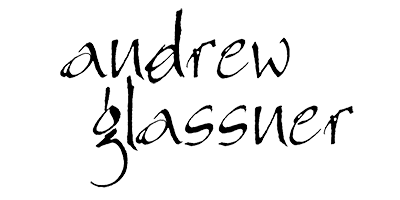Graphics Gems Series
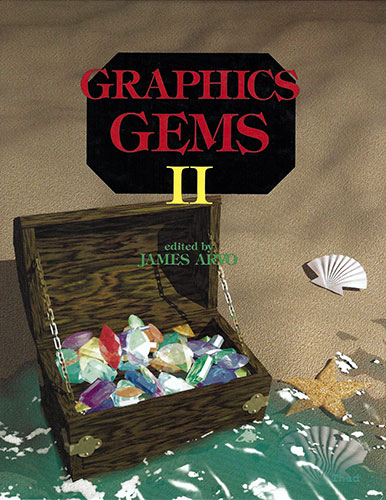 The fist Graphics Gems book surprised us all with its popularity. It seemed clear that a lot of people liked this idea of small, bite-sized bits of practical knowledge. I’d received more contributions for the first volume than we could print. It seemed like the most obvious thing in the world to make another book.
The fist Graphics Gems book surprised us all with its popularity. It seemed clear that a lot of people liked this idea of small, bite-sized bits of practical knowledge. I’d received more contributions for the first volume than we could print. It seemed like the most obvious thing in the world to make another book.
I considered editing the second book, but I felt that I had exercised a lot of personal choice in the first book (as an editor is supposed to do, of course). I thought that if I could find a talented colleague with the time and interest to be the next editor, it would help stir up the “gene pool” of ideas. I wanted this new book to have its own personality. I was thrilled when my friend and colleague Jim Arvo agreed to be the editor for the second book.
Settling on a name for this second book was harder than I thought. Many people wanted to use “More Graphics Gems”, but I thought that if there were more volumes to come (as indeed there were), we would end up with titles like “Still Yet Even More Graphics Gems.” Happily, Graphics Gems II won out, and the pattern was established.
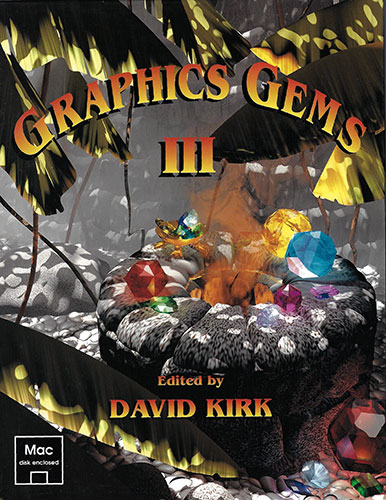 As the Series Editor, my most important jobs were selecting and helping the editor of each volume. I also drew the chapter-opening graphics and wrote a preface. I am very pleased and proud that the next three books were edited by David Kirk, Paul Heckbert, and Alan Paeth.
As the Series Editor, my most important jobs were selecting and helping the editor of each volume. I also drew the chapter-opening graphics and wrote a preface. I am very pleased and proud that the next three books were edited by David Kirk, Paul Heckbert, and Alan Paeth.
One reason that the Gems series was popular was because it was populist: the profits went back to the contributors. Often in a large volume with dozens of contributors, each person is paid a flat fee upon acceptance of the piece, and then the royalties from the books go to the editors and publishers. I felt that the Gems books were by the community, and for the community. I set up a royalty scheme where the profits were considered to be a big pie, and each contributor got one slice per contribution. There was a little play in the system – some small entries got clustered together, and the editor got a few extra slices for his service. So every contributor got paid something for every book sold. Royalty checks continue to be mailed out even today.
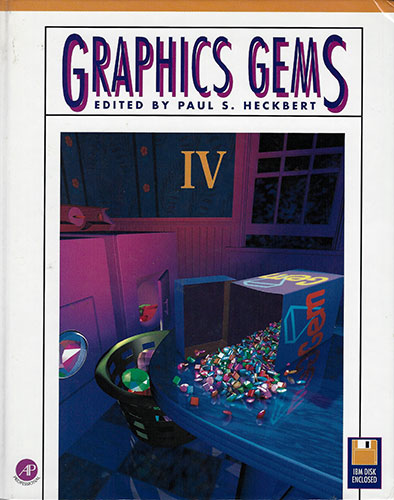 Another nice part of the Gems series was that I watned as many of the contributions as possible to come with real, working source code. And I wanted that source code to be free. Sharing source code freely was still a pretty radical idea at the time, but I felt strongly that this was the right way to share this work. So each book contains source listings, and some of the later books include disks. You can download all of the Gems code, including bug fixes, from the terrific Graphics Gems Code Repository, a site run by Eric Haines.
Another nice part of the Gems series was that I watned as many of the contributions as possible to come with real, working source code. And I wanted that source code to be free. Sharing source code freely was still a pretty radical idea at the time, but I felt strongly that this was the right way to share this work. So each book contains source listings, and some of the later books include disks. You can download all of the Gems code, including bug fixes, from the terrific Graphics Gems Code Repository, a site run by Eric Haines.
Once we’d reached the fifth book in the series I felt that we had done our job. The flood of pent-up tricks had reduced to a drizzle, which told me that we had emptied people’s drawers and notebooks. That seemed like a good time to wrap up the series. We made five terrific books, and that was plenty!
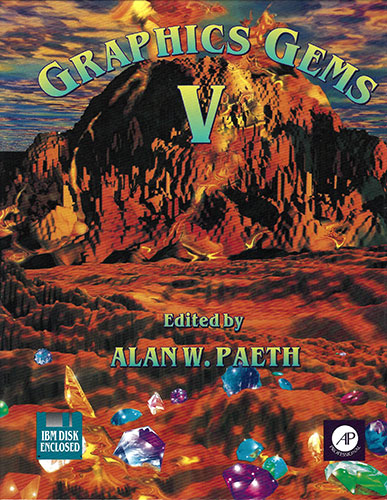 After some time I felt that there should be a place for new, small tips and techniques like those in the Gems series, even though I knew that more books wasn’t the answer. A journal, however, seemed just the right vehicle. I was delighted to found The Journal of Graphics Tools, published by AK Peters. This has morphed into the Journal of Computer Graphics Techniques, which I am happy to say is completely free in every way: free to contribute to, free to publish in, and free to read. JCGT is the first truly open, online, free computer graphics journal, and I couldn’t be happier. JCGT maintains publication and review standards that are at least as high as any print journal: the peer reviews are in-depth and the editors work hard to make every paper as good as it can be.
After some time I felt that there should be a place for new, small tips and techniques like those in the Gems series, even though I knew that more books wasn’t the answer. A journal, however, seemed just the right vehicle. I was delighted to found The Journal of Graphics Tools, published by AK Peters. This has morphed into the Journal of Computer Graphics Techniques, which I am happy to say is completely free in every way: free to contribute to, free to publish in, and free to read. JCGT is the first truly open, online, free computer graphics journal, and I couldn’t be happier. JCGT maintains publication and review standards that are at least as high as any print journal: the peer reviews are in-depth and the editors work hard to make every paper as good as it can be.
If you have an idea that you think would have been about right for Graphics Gems, consider sending it to JCGT.
By the way, please be aware that there are other books that have the word “Gems” in the title. Although some of these are quite good, some are not. None of them are associated with the Graphics Gems series, nor have I been involved in their production.
Thad Beier designed and rendered the cover for Gems II, reprising his role from the first book. The cover for volume III was made by the VALIS group using an early version of RenderMan. The laundry room of Volume IV’s cover was made by Eben Ostby of Pixar. I don’t know where the Volume V cover image came from, but I had nothing to do with it!
These books are all still available online. Amazon lists new and used copies for Gems II, Gems III, Gems IV, and Gems V.
